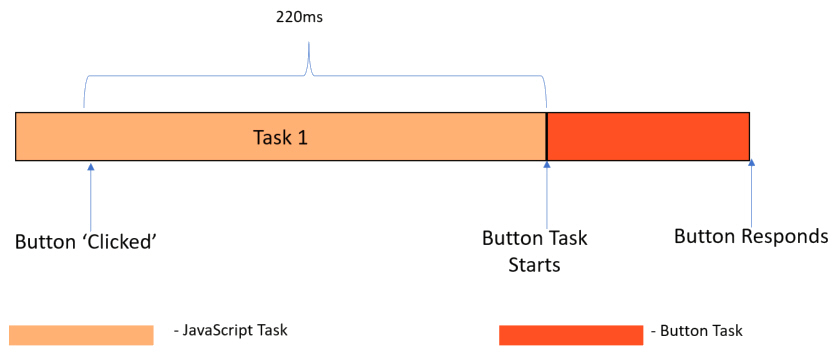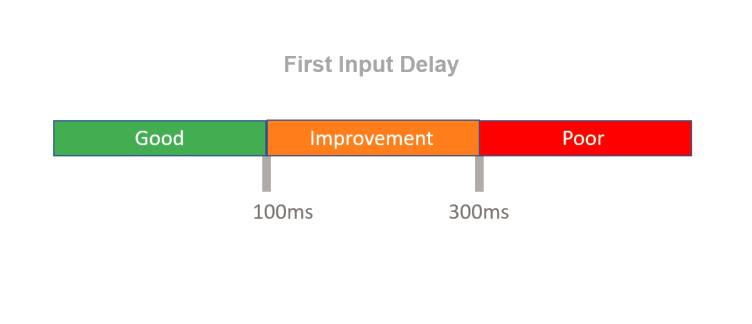First Input Delay
What is First Input Delay
The First Input Delay (FID) is a custom created metric that is designed to measure how quickly a visitor to your website can interact with a web page. Its objective is to establish a set of measurement criteria that can be used to improve the key user experience aspects of interactivity and responsiveness.
This metric is calculated algorithmically by measuring the amount of time it takes for the browser to be able to respond to the first input request made by the visitor, such as entering data into an input field or clicking on a link.
The value of this metric is that it provides a quantifiable measurement of how long the initial delay is for website visitors when trying to interact with web pages. If FID is high, then the web page is considered unresponsive.
Why does FID matter?
An important aspect of viewing a web page is to be able to interact with it, even if it is just to scroll for content not initially displayed on the viewable screen area (viewport).
However, the user experience may be directly affected if the browser is unable to respond to the click, scroll or input request in a timely manner.
A high FID value indicates that the browser is busy with other tasks and it is these tasks that prevent the visitor from interacting with the web page. This may result in a poor user experience which may directly lead to a poor perception of the website and possibly the brand.
What Marketing Metrics does FID affect?
FID is a Google Core Web Vital metric that is designed to validate the first impression of interactivity and responsiveness as part of a wider initiative to improve overall user experience.
Where FID measures are poor, search rank of the web page may be impacted. Furthermore, web pages with a high FID value may also impact on purchase confidence, site experience and trust.
The following summarizes how poor FID can impact conversions:
- The User's first impression of the responsiveness of a website.
- Bounce rate, which is amplified on a mobile connection, if a user is not able to quickly interact with the web page they are unlikely to remain on the website.
- On-site conversion, the ability for a user to click a button such as add to cart or a product link.
- Search Ranking, as a Core Web Vital, Google will use FID in its indexing algorithms as a ranking signal favouring web pages that provide a high quality user experience.
How is FID calculated?
FID is a calculated metric that only measures the time delay incurred before an event or requested action, such as a button clicked, is processed.
It does not measure the event processing time itself or the time the browser takes to update the on-screen view (viewport) after processing the event.
For any input request to be processed, it requires the browser’s main processing thread to be free before the request can be enacted upon.

Figure 1: simple example of how FID is calculated.
Figure 1 shows a simple example of input delay. While the browser is processing a JavaScript task, Task 1, the visitor initiates an action, in this case a button is clicked that is visible in the viewport.
Before the button click can be enacted upon, the browser must wait for the JavaScript task to end. At this time, the button request (event) is then processed.
In Figure 1 the FID is calculated as 220ms which is the time from when the button is clicked to the time when the button task can start to process the request.
However, the time taken to process the button event and respond to the visitor (Button Task Starts to Button Responds), is not included in this delay time.
What is a good FID score?
Google considers an FID score of 100ms or less to be representative of a good user experience and this value must be achieved to pass the Core Web Vitals assessment criteria.
An FID value above 300ms is considered to represent a poor user experience.

All Core Web Vital criteria are assessed at the 75th percentile of all observed page loads.
What causes Poor FID?
Poor FID often results from heavy JavaScript on the page.
If the browser is busy executing a large JavaScript file it is unable to process any input requests until, as a minimum, it completes the current processing JavaScript task.
How can FID be Tracked?
FID metrics can only be collected from real-user data, as collected by, Page Speed Insights or other commercial software tools, and is therefore a true measurement of interactivity and what actually happens on your website.
If it is not possible to collect FID metrics from these sources, then Total Blocking Time (TBT), which can be collected using "Lab Testing" methods is considered a suitable surrogate metric.
Google has provided several different "Lab Testing" methods that enable observation of the TBT metric, such as Google Lighthouse, These tools provide a snapshot view which can be a good reference check.
However, to establish a true benchmark of FID or TBT performance, observations need to be collected over time. This aids historical analysis and observation of changes on web pages and how they affect the FID metric.
As Google now use this metric to form part of their ranking algorithms understanding how you compare against business competitors is vital – Webspeed Index can rank sites based on their FID performance to give you a real time view of your competitive landscape.
Webspeed Index provides comprehensive functionality that enables you to chart FID and TBT performance over time. Benchmarking against other web pages, both internal and competitive, enables the measurement of performance to track improvement and identify any regression that may result from any website or content changes.
Contact Webspeed Index today to get a health check on the key metrics of your pages.





